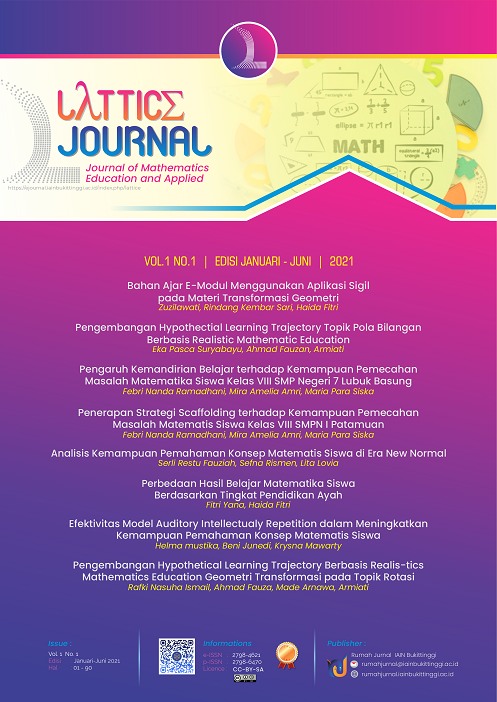Efektivitas Model Auditory Intellectualy Repetition dalam Meningkatkan Kemampuan Pemahaman Konsep Matematis Siswa
DOI:
https://doi.org/10.30983/lattice.v1i1.4787Keywords:
Model Pembelajaran Auditory Intellectually Repetition (AIR), Pemahaman KonsepAbstract
This research is motivated by the low ability of students to understand mathematical concepts. The Auditory Intellectually Repetition (AIR) learning model can be used as an innovative teaching solution in improving the ability to understand concepts because the Auditory Intellectually Repetition (AIR) learning model is a learning model that emphasizes three aspects, namely learning by listening, learning by thinking and repetition. This study aims to determine the effectiveness of the Auditory Intellectual Repetition (AIR) learning model in improving students' understanding of mathematical concepts. The design of this research is Pre Experimental with the form of research used is One Group Pretest-Posttest Design. The sampling technique used is Simple Random Sampling. After the samples were taken randomly, class X IPA 2 was chosen as the experimental class. The instrument in this study was in the form of a student's mathematical concept understanding ability test. The data analysis technique in this study used N-Gain data and the Paired Sample T Test (t test). Based on the average N-Gain value, it can be concluded that the Auditory Intellectual Repetition (AIR) learning model is effective in improving students' mathematical concept understanding abilities.
Â
Penelitian ini dilatarbelakangi oleh masih rendahnya kemampuan pemahaman konsep matematis siswa. Model pembelajaran Auditory Intelletually Repetition (AIR) dapat dijadikan suatu solusi pengajaran yang inovatif dalam meningkatkan kemampuan pemahaman konsep karena model pembelajaran Auditory Intellectually Repetition (AIR) merupakan model pembelajaran yang menekankan tiga aspek, yaitu belajar dengan mendengar, belajar dengan berfikir dan pengulangan.  Penelitian ini bertujuan untuk mengetahui model pembelajaran Auditory Intelletually Repetition (AIR) efektif dalam meningkatkan kemampuan pemahaman konsep matematis siswa.  Desain penelitian ini adalah Pre Experimental dengan bentuk penelitian yang digunakan adalah One Group Pretest-Posttest Design. Teknik pengambilan sampel yang digunakan adalah Simple Random Sampling. Setelah sampel diambil secara acak, terpilih kelas X IPA 2 sebagai kelas eksperimen. Instrument dalam penelitian ini berupa tes kemampuan pemahaman konsep matematis siswa. Teknik analisis data dalam penelitian ini menggunakan data N-Gain dan uji Paired Sample T Test (Uji t). Berdasarkan rata-rata nilai N-Gain dapat disimpulkan bahwa model pembelajaran Auditory Intelletually Repetition (AIR) efektif dalam meningkatkan kemampuan pemahaman konsep matematis siswa.
References
Makmur, Agus. (2015). “Efektifitas Penggunaan Metode Base Method dalam Meningkatkan Kreativitas dan Motivasi Belajar Matematika Siswa SMP N 10 Padang Sidimpuanâ€. Jurnal EduTech. 1, (1).
Sarinah, Siti, dkk. (2019). “Pengaruh Model Pembelajaran Auditory Intellectualy Repetition (AIR) terhadap Kemampuan Pemahaman Konsep Matematis. Jurnal of Madives. 3, (1), halaman 94
Simamora. (2019). “Efektivitas Model Pembelajaran Audiotory Intellectualy Repetition (AIR) dengan Kemampuan Pemecahan Masalah Matematis Siswa di SMK Kesehatan Sidimpuan Husadaâ€. Jurnal MatEdu. 2, (2) , halaman 29
Siregar, HL, dkk. (2020). “Efektivitas Penggunaan Model Pembelajaran Audiotory, Intellectually, repetition (AIR) terhadap Pemahaman Konsep Matematika Siswa. Jurnal MathEdu. 3, (3), halaman 43
Wijaya, dkk.(2018). “Kemampuan Pemahaman Matematis Siswa Menggunakan Model Pembelajaran Audiotory Intellectually.
Downloads
Submitted
Accepted
Published
Issue
Section
License
Authors who publish with Lattice Journal : Journal of Mathematics Education and Applied agree to the following terms: Authors retain copyright and grant the Lattice Journal : Journal of Mathematics Education and Applied right of first publication with the work simultaneously licensed under a Creative Commons Attribution License (CC BY-SA 4.0) that allows others to share (copy and redistribute the material in any medium or format) and adapt (remix, transform, and build upon the material) the work for any purpose, even commercially with an acknowledgement of the work's authorship and initial publication in Lattice Journal : Journal of Mathematics Education and Applied. Authors are able to enter into separate, additional contractual arrangements for the non-exclusive distribution of the journal's published version of the work (e.g., post it to an institutional repository or publish it in a book), with an acknowledgement of its initial publication in Lattice Journal : Journal of Mathematics Education and Applied. Authors are permitted and encouraged to post their work online (e.g., in institutional repositories or on their website) prior to and during the submission process, as it can lead to productive exchanges, as well as earlier and greater citation of published work (See The Effect of Open Access).









